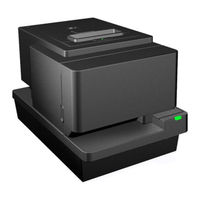
DIEBOLD NIXDORF P1300 Manuals
Manuals and User Guides for DIEBOLD NIXDORF P1300. We have 2 DIEBOLD NIXDORF P1300 manuals available for free PDF download: Programming Manual, User Manual
DIEBOLD NIXDORF P1300 Programming Manual (256 pages)
Hybrid Printer
Brand: DIEBOLD NIXDORF
|
Category: Printer
|
Size: 4 MB
Table of Contents
-
General12
-
Receipt12
-
Slip13
-
Emulation15
-
Play Melody28
-
Close Form29
-
Open Form29
-
Return Home30
-
Print33
-
Set Column37
-
Print Logo58
-
Transmit Status100
-
Clear Buffer(S)109
-
Print Bar Code118
-
Macro Commands146
-
Execute Macro146
-
Set Paper Type170
-
Flash Firmware186
-
General209
-
Paper Reduction209
-
Power Reduction213
-
Stand-By Mode214
-
Power off Mode214
-
Speed Reduction214
-
Outline216
-
Diagnostics232
-
Sensor Test246
-
Printer Errors249
Advertisement
DIEBOLD NIXDORF P1300 User Manual (75 pages)
Hybrid Printer
Brand: DIEBOLD NIXDORF
|
Category: Printer
|
Size: 4 MB
Table of Contents
-
Unpacking12
-
Introduction13
-
Features13
-
Accessories14
-
General15
-
General18
-
Main Card19
-
Reliability20
-
Life20
-
Options22
-
Receipt Roll23
-
Appearance26
-
Power Button28
-
Connectors29
-
Diagnostics48
-
Appendix69

